Falcons are raptors of the genus Falco. There are about 40 species of them that can be sited across the globe except for Antarctica. Falcons are often confused for hawks or eagles because they are all birds of prey with striking physical similarities. However, falcons kill their prey using their beaks, as opposed to hawks, eagles, and other raptors that use their feet.
Falcons mainly inhabit the coastlines, mountain ranges, and river valleys. They are diurnal birds of prey that feed primarily on other birds and smaller mammals like mice. Some species of falcon, like the peregrine falcon, are considered endangered.
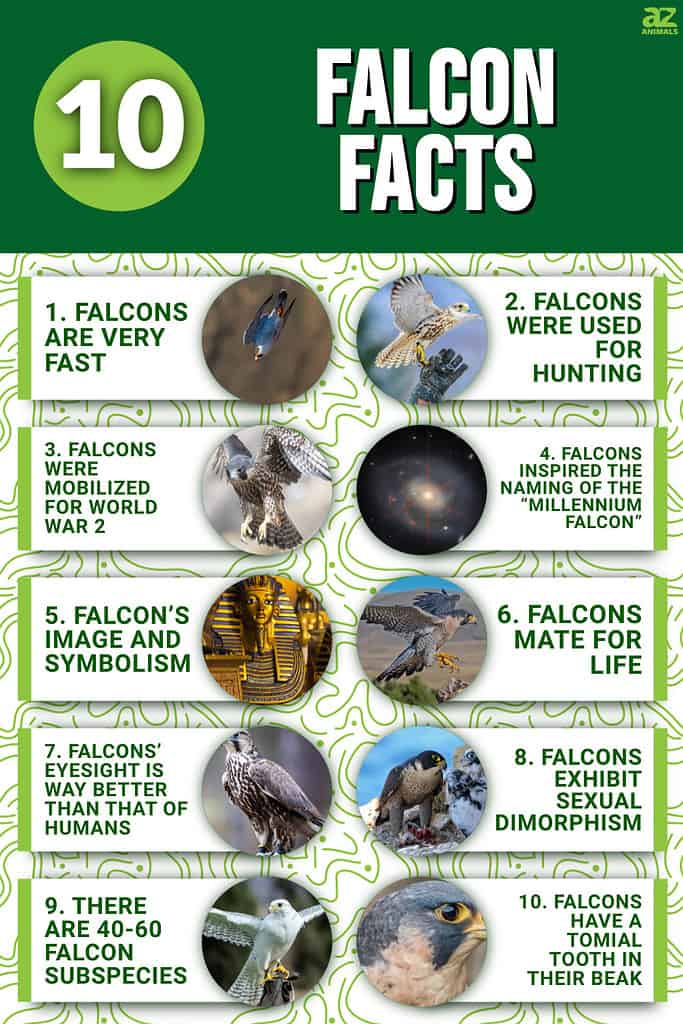
Let’s take a look at the ten most incredible facts about falcons.
1. Falcons are very fast
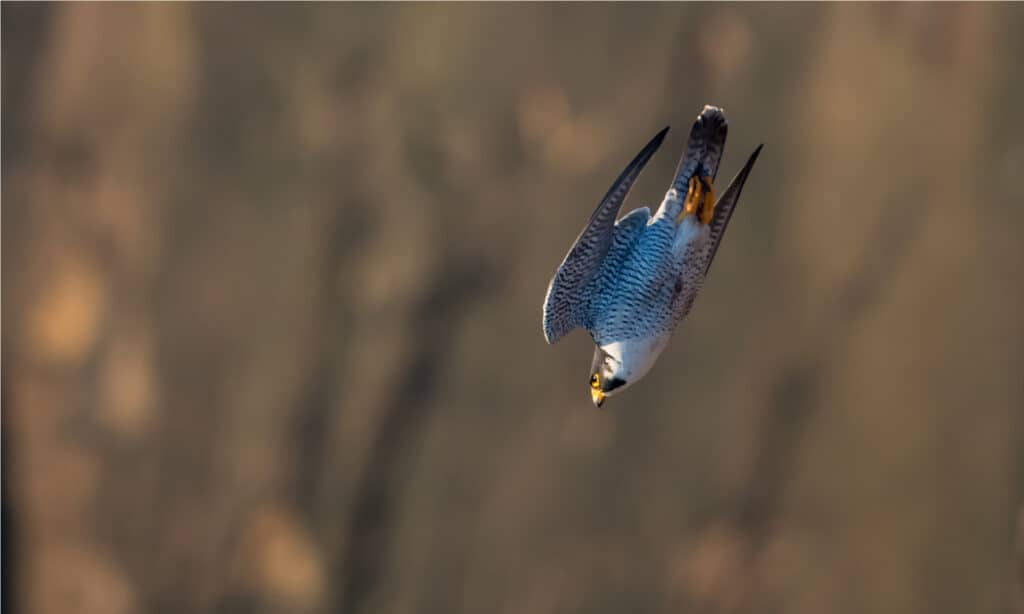
Peregrine falcons can attain very high diving speeds of more than 200 mph.
©Harry Collins Photography/Shutterstock.com
The peregrine falcon (Falco peregrinus) has been credited as the fastest animal in the world. According to Benjamin Ponitz, when peregrine falcons are on a hunt, they can attain very high diving speeds of more than 200 mph (320 km/hr) to catch agile prey.
Their mind-blowing speeds cannot be compared to the fastest land animal, the cheetah, which can run at 50 to 80 mph (80-128 km/hr). Peregrine falcons also hold the Guinness world record for being the fastest animal globally.
2. Falcons were used for hunting

Falconry, the ancient sport of using birds of prey to hunt, has existed for at least 4,000 years.
©Krasula/Shutterstock.com
Humans used falcons for hunting in ancient China, Arabia, and Persia. In the modern era, falconry has become a revered sport and is widespread in places like the UAE, where falcons have been declared a national bird.
In 2016, the United Nations Educational, Scientific and Cultural Organization (UNESCO) declared falconry part of human intangible cultural heritage, and falcons are among the bird species used for falconry.
3. Falcons were mobilized for World War 2

Falcons were used to intercept pigeons used in World War Two.
©TPCImagery – Mike Jackson/Shutterstock.com
Falcons were used to intercept pigeons used in World War Two. During the war, trained pigeons were used to transmit messages and carry out surveillance. To counter this, the defending or offending army would use falcons.
Falcons would capture and eat the pigeons, thereby sabotaging message transmission by rival armies. The German and allied forces deployed a squadron of Peregrine Falcons in the Second World War.
4. Falcons inspired the naming of the “Millennium Falcon”

Naming spaceships in fiction and real life is nothing new.
©ESA/Webb, NASA & CSA, L. Armus, A. S. Evans, CC BY 4.0, via Wikimedia Commons – License
Falcon 9, a two-stage reusable rocket made by SpaceX, was named after the Star Wars movie Millennium Falcon ship. The Millennium Falcon had its name inspired by the Bat Falcon, also known scientifically as Falco rufigularis. Falcons have inspired the naming of planes, ships, and even sports teams because the use of their image is intensely symbolic.
5. Falcon’s image and symbolism
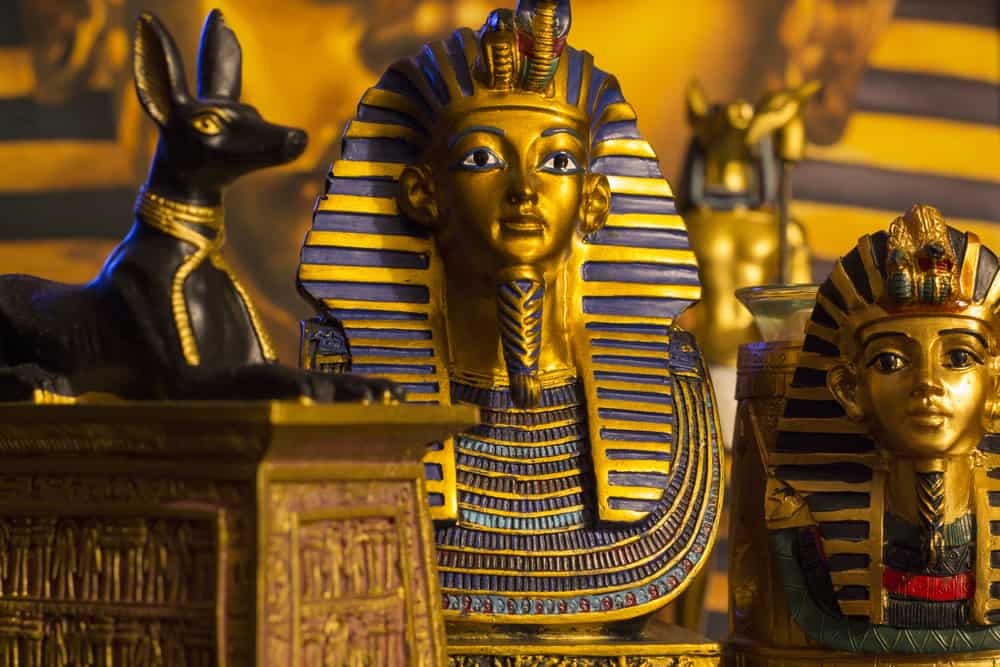
Falcons represented Egyptian deities like the god Horus, the god of justice and order.
©JK21/Shutterstock.com
The falcon’s image has been used since immemorial to represent different things and portray various meanings. The symbolism can be contradictory depending on other societies. In ancient Egypt, where the falcon was considered sacred, it represented deities like the god Horus, the god of justice and order. It was believed then that every Pharaoh was a reincarnation of this deity who defeated Seth, the god of death. To the Vikings, it represented the appearance of the god Odin and the power of Freyja.
In Native American culture, they represent courage, power, and strength. As a result of the potent symbolism of the falcon image, it is widely used in logos and emblems and is very important in heraldry. In some cultures, though, falcons are associated with death and evil.
6. Falcons mate for life
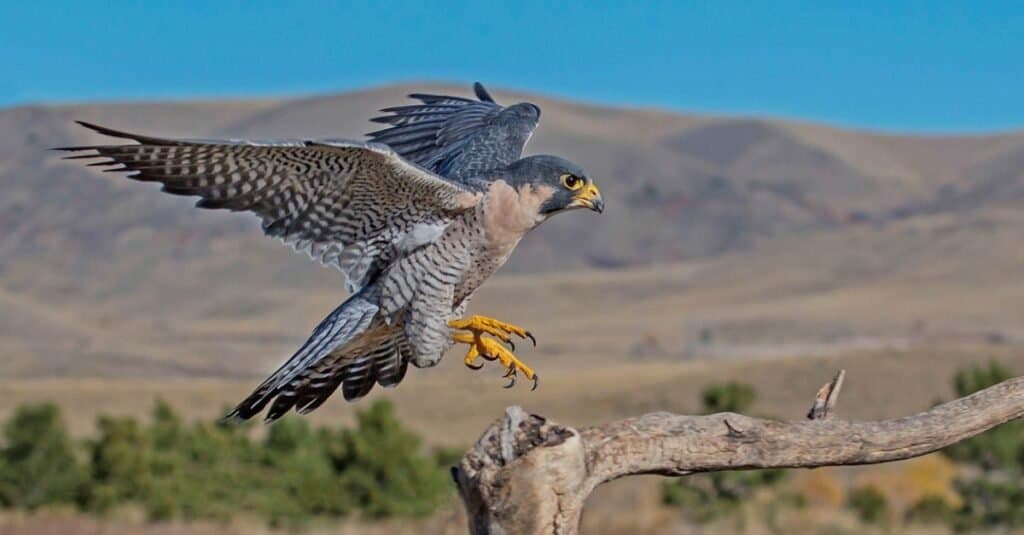
Falcons commit to one partner for the duration of their productive life.
©iStock.com/DawnKey
Falcons value fidelity and commit to one partner for the duration of their productive life. They form a solid affinity for their nesting sites. However, it doesn’t mean that males and females will spend their entire lives living closely as “couples.” These raptors only come together to mate and spend most of their time as solitary hunters during non-breeding seasons.
7. Falcons’ eyesight is way better than that of humans
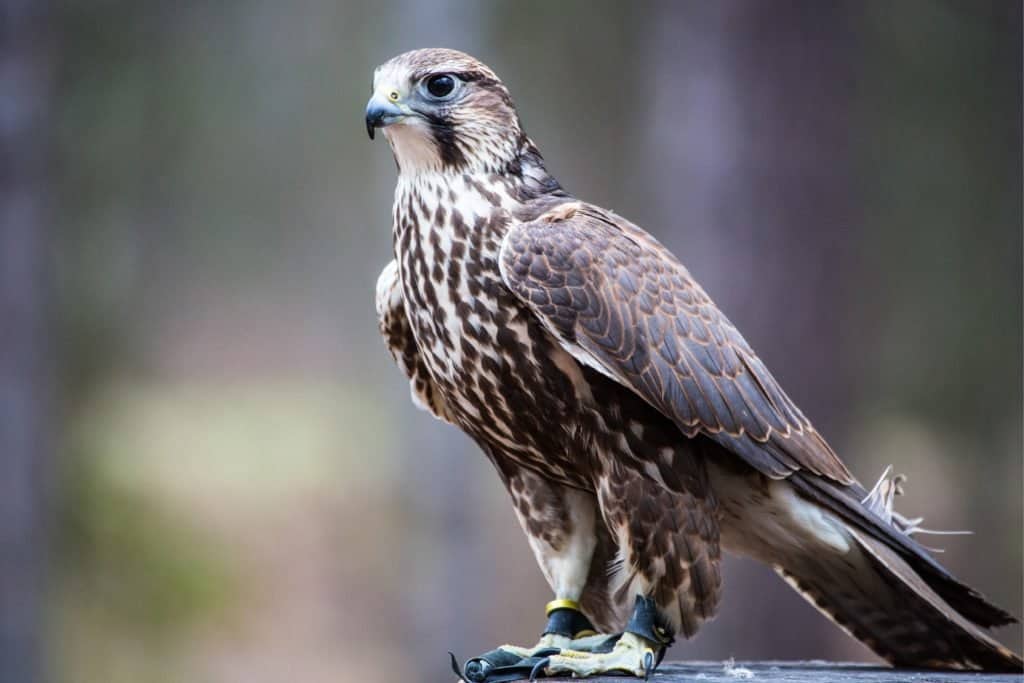
Falcons’ eyes can focus independently.
©Gary C. Tognoni/Shutterstock.com
Falcons are designed to see even at high speeds with their higher flicker fusion frequency. The Falcon’s eyesight power is an inspiration for naming Texas Instrument’s FLIR system “Falcon’s eye.” The FLIR is based on advanced detector technology used in navigation.
Their eyesight is better than that of humans, an endowment they leverage to spot prey from a great distance. Falcons have a focal point on the retina that’s found at the back of each eye, which assimilates the photo lens. Therefore, they use each eye independently to focus on up to three objects simultaneously. This makes it possible for them to focus on more than one prey item at a time.
8. Falcons exhibit sexual dimorphism
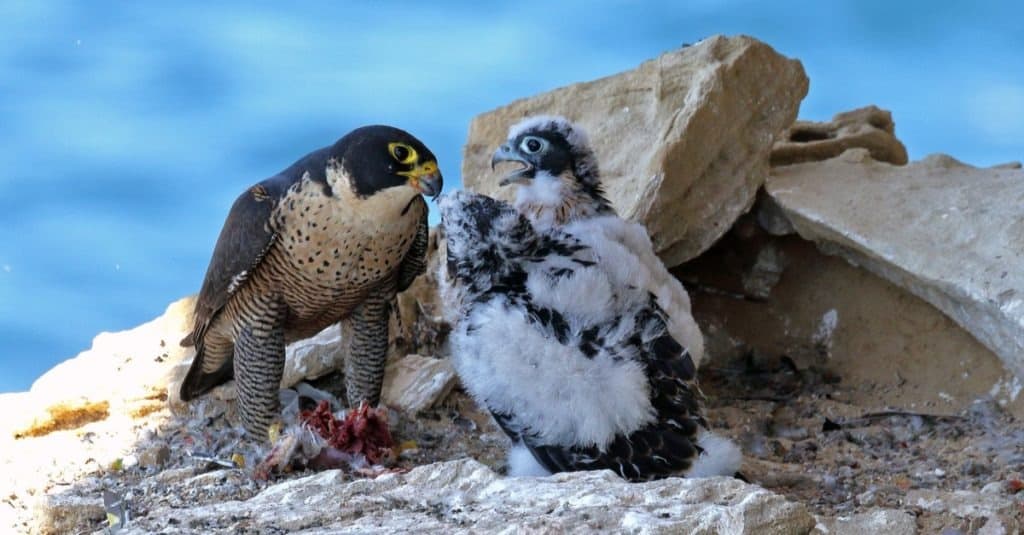
Female falcons are larger than their male counterparts.
©Ken Griffiths/Shutterstock.com
Sexual dimorphism refers to the systematic size difference in species based on sex/gender, i.e., one gender being constantly bigger or smaller than the other. For falcons, the female is larger than the male, a common avian phenomenon.
The sexual dimorphism in falcons is believed to be an adaptation that helps breeding mates pursue a wide range of prey. This adaptability in size makes one swifter for catching smaller mammals and the other for hunting bigger prey; hence, they can focus on their strength to “put food on the table.”
9. There are 40-60 falcon subspecies
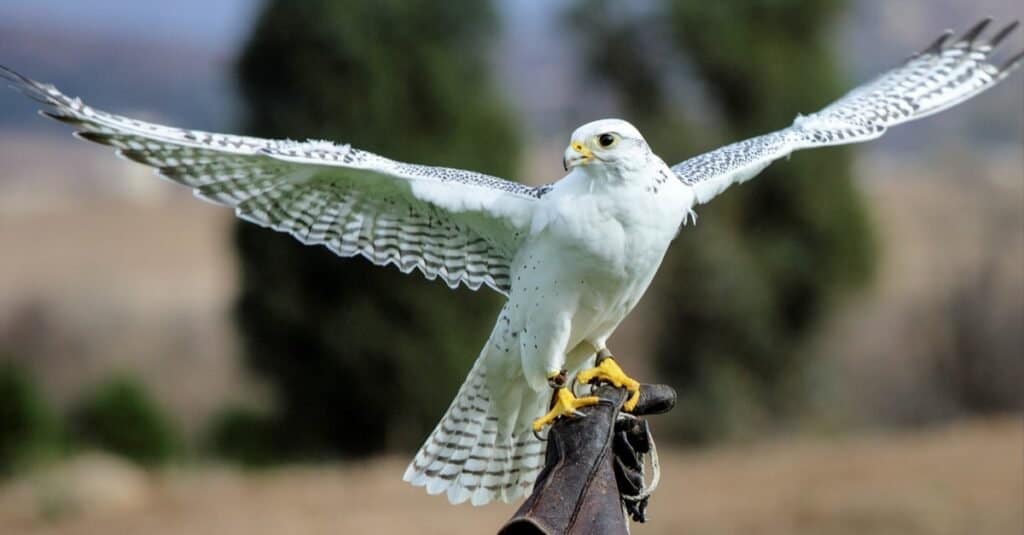
The gyrfalcon is the largest falcon worldwide.
©John Hancock/Shutterstock.com
It is estimated that 40-60 subspecies of falcon exist all over the world, with the largest falcon being the gyrfalcon. Smaller falcon species are the pygmy falcon and the American kestrel.
Also known as the African pygmy falcon, the pygmy falcon (Polihierax semitorquartus) is considered the smallest raptor in the world. Its length is about 8 inches (20 cm) from tail to head, and it weighs between 1.5-3 inches (42-85 g).
The gyrfalcon is the largest falcon worldwide. It weighs between 2.1 and 4.4 pounds upon attaining maturity. It is one of the rarest falcons owing to its habitat and nesting grounds, mostly in remote cliff areas. The gyrfalcon’s diet primarily consists of ptarmigans, but it also preys on other bird species such as seagulls and jaegers.
10. Falcons have a tomial tooth in their beak
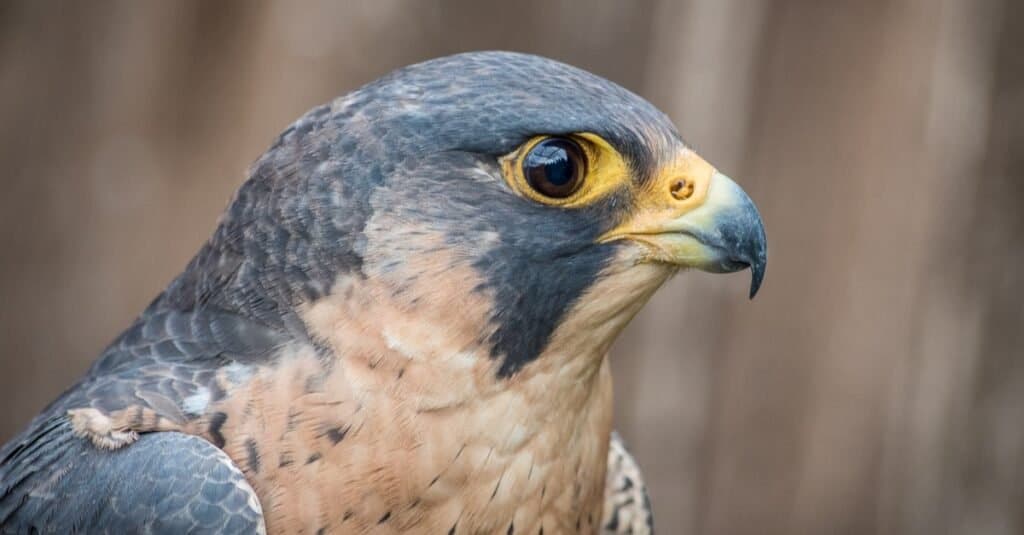
Falcons tomial tooth helps finish off their prey!
©iStock.com/RamonCarretero
The protrusion in the falcon’s upper bill is called a tomial tooth and corresponds to a ridge in the lower mandibles. This adaptation makes it possible for them to use their beaks as a weapon to sever the spinal cord of their prey. Interestingly, both the talons and beaks of falcons are made of keratin and can sometimes break just as humans’ nails do upon extensive use.
The photo featured at the top of this post is © WildlifeWorld/Shutterstock.com
Thank you for reading! Have some feedback for us? Contact the AZ Animals editorial team.






